Your entire tackle box: 3″ cigar floats, 80 lb. swivels, tiny beads, bullet weights, 3″ DOA Shrimp, Barefoot Jigs, 5/0 or 6/0 VMC circle hooks and live shrimp.
The sliding cork has been, and always will be, one of the most effective tools in any fisherman’s arsenal. Of course, we grew up fishing for everything from crappie to speckled trout and catfish under a sliding cork, with live and cut bait, but now I have incorporated artificial baits/lures into the mix under the sliding cork.
For example, I have a rocky bottom area that’s 9 feet deep on high water, and a D.O.A. Shrimp set 7 feet deep is extremely effective on trout and red drum using this method. First and foremost, you don’t stay hung up in the rocks and oysters. It keeps the shrimp in the “strike zone,” drifting at the exact speed of the tide. It’s also a great way to cover a large area using the tide to take your bait as far away as you want to let it go. You can’t possibly cast a bait as far as you can let it drift. We’ve caught several hundred trout at this place over the years with live shrimp, but I’ve switched to artificial shrimp for convenience.
The sliding cork has long been our weapon of choice for making long drifts down the river for catfish and striped bass. It’s a great way to locate an area that’s holding fish. Once you start getting bites in an area along the drift, you can concentrate efforts where the fish are. One of my favorite places to do this is a stretch of river 16 feet deep for a quarter mile. We’ll set the cork at 14 feet and effectively fish the entire stretch without getting hung up. The sliding cork keeps the bait at the perfect depth and speed.
Note: Keep an eye on the position of your cork. It will stay upright as the weight keeps tension on it. If you see the float lay over, it means you just had a bite because a lot of the bites are from fish rising to eat the bait. Shortly after, you see the float go under or start moving away.
This setup is also deadly effective on shallow-water grouper. Some areas along the west coast of Florida hold grouper in very shallow water. You can t get right on top of these fish to “bottom fish,” and I prefer this subtle approach as opposed to trolling. First, get up-current or up-wind from a rock and drift a nice bait back to them. Then, when you see the float go under, get the fish in quickly, or they will run into the structure and break you off.
The key takeaway: A sliding cork has applications for dozens, if not hundreds, of places and species of fish.
What you need to make your own Sliding Cork:
-
Snelled 5/0 or 6/0 VMC circle hook for live shrimp
- 3″ DOA Shrimp and a Barefoot Jig for artificial bait
-
20-lb. fluorocarbon leader
-
20-lb. braid mainline
-
80-lb. Spro swivel
-
5/16 bullet weight
-
Tiny beads – 1/8″ – .125 in diameter
-
3″ cigar float
-
Float Keeper is a piece of 20lb. fluorocarbon tied to the braid mainline using a 3 loop uni knot
SALTWATER TACKLE YOU MIGHT WANT TO TRY:
7/0 and 11/0 J-Hook Ching Weights: Target fish include Tuna, Wahoo, Mahi or Common Dolphin, King Mackerel, Wahoo, and more. Easy to rig!
4 oz. Crab Decoy Jig: Target fish for Striped Bass, nearshore Drum, Snook, Grouper, west coast bottom fish, and more.
4 oz. Tuna Squid Decoy Jig: From the eastern, western, Alaskan, and gulf coasts, target fish include: Tuna, Dolphin, Wahoo, Fluke, Flounder, Striped Bass, Seabass, Amberjack (east coast), Yellow Tail (west coast), California White Sea Bass (west coast), Grouper, Snapper, Halibut, Ling cod, and all Alaskan bottom fish.
8 oz. - 12 oz. 10/0 Squid Decoy Jig: Catch BIG Grouper, Amberjack, Giant Stripers, and more.





